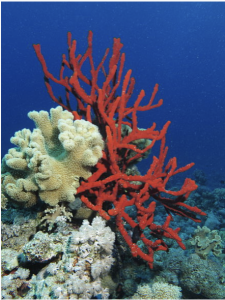
Toxic Negombata magnifica sponge at Shaab el Erg reef (Red Sea, Egypt) (Alexander Vasenin, 2010)
With an ever-increasing demand for novel drug therapies, scientists are turning to marine organisms as a source of bioactive chemicals, whose properties can be harnessed for medical development. One such organism is a rather unlikely candidate: the sea sponge (phylum Porifera). Lacking a brain and a central nervous system, sea sponges rely upon specialized cells to perform their required functions. As result of their structural simplicity and sedentary existence, these ancient creatures have evolved to protect themselves against predation by means of toxic chemicals, which can prove similarly lethal to cancer cells and microbes in humans (El-Naggar et. al., 2022). A study published in Applied Sciences examined the properties of two sponge species, Negombata magnifica (finger sponge) and Callyspongia siphonella (tube sponge). This drew from the scientists’ previous study, which had indicated that all eight extracts of finger-sponge and tube-sponge studied promoted the death and inhibited the growth of cells associated with liver, breast, and colorectal cancer (El-Naggar et.al., 2022).
Whereas the earlier study had used four different solvents in the production of sponge extracts, this newerstudy examined only the methanolic extracts of Negombata magnifica (NmE) and Callyspongia siphonella (CsE). Sponge specimens were collected from the Dahab region on the Sinai Peninsula and soaked with methanol to obtain NmE and CsE. One microliter of each extract was examined for its contents of bioactive compounds via a Gas Chromatography–Mass Spectrometer (GC–MS analysis). Out of the 117 chemical compounds revealed by GC–MS analysis, 37 were determined to be bioactive. These compounds were tested against cultured liver, breast, and colorectal cancer cell lines and ten test microorganisms representing filamentous fungi, yeasts, and Gram-positive and Gram-negative bacteria (El-Naggar et.al., 2022).
While CsE showed no antiproliferative action against the cancer cells, NmE dose-dependently impeded their growth: it induced cell cycle arrest in the liver cancer lines by inhibiting the cell division protein CDK6. It also halted mitotic progress in all three cell types by inhibiting D1 and E1 cyclins, which regulate progression through the cell cycle (Alao, 2007). Furthermore, NmE activated reactive oxygen species (ROS) production in liver cancer cells and induced apoptosis in all cell lines, via Bax (a pro-apoptotic regulatory protein) and caspase-3 (a death protease that cleaves cellular proteins) increase and BCL2 (an anti-apoptotic regulatory protein) decrease (Blanco and García-Sáez, 2018) (Ponder and Boise, 2019; Youle and Strasser, 2002). Regarding antimicrobial activity, CsE was shown to be a superior antimicrobial agent by acting against six microbial strains, whereas NmE reacted favorably to only two strains (El Naggar et. al., 2022).
Looking forward, the anti-cancer properties of NmE indicate its potential for development as an anti-cancer drug, while CsE is a promising source for antimicrobial drug discovery. Additionally, several of the compounds’ bioactivity is neither anti-cancer nor antimicrobial—for instance, both fenretinide and ethyl iso-allocholate have been attributed to anti-COVID-19 activity (Orienti, et. al., 2020; Poochi et. al., 2020). Ultimately, given that approximately eighty of the compounds have yet to be attributed to anti-cancer or anti-microbial mechanisms, the study emphasizes the importance of looking to Earth’s oceans as potential sources of bioactive compounds and harnessing the biological potential of marine organisms in the development of novel drug therapies.
References:
Alao, J.P. The regulation of cyclin D1 degradation: roles in cancer development and the potential for therapeutic invention. Mol Cancer 6, 24 (2007). https://doi.org/10.1186/1476-4598-6-24
El-Naggar, H. A., Bashar, M. A. E., Rady, I., El-Wetidy, M. S., Suleiman, W. B., Al-Otibi, F. O., Al-Rashed, S. A., et al. (2022). Two Red Sea Sponge Extracts (Negombata magnifica and Callyspongia siphonella) Induced Anticancer and Antimicrobial Activity. Applied Sciences, 12(3), 1400. MDPI AG. Retrieved from http://dx.doi.org/10.3390/app12031400
Orienti, I.; Gentilomi, G.A.; Farruggia, G. Pulmonary Delivery of Fenretinide: A Possible Adjuvant Treatment in COVID-19. Int. J. Mol. Sci. 2020, 21, 3812.
Peña-Blanco, A., & García-Sáez, A. J. (2018). Bax, Bak and beyond – mitochondrial performance in apoptosis. The FEBS journal, 285(3), 416–431. https://doi.org/10.1111/febs.14186
Ponder, K.G., Boise, L.H. (2019). The prodomain of caspase-3 regulates its own removal and caspase activation. Cell Death Discovery 5, 56. https://doi.org/10.1038/s41420-019-0142-1
Poochi, S.P.; Easwaran, M.; Balasubramanian, B.; Anbuselvam, M.; Meyyazhagan, A.; Park, S.; Bhotla, H.K.; Anbuselvam, J.; Arumugam, V.A.; Keshavarao, S.; et al. Employing bioactive compounds derived from Ipomoea obscura (L.) to evaluate potential inhibitor for SARS-CoV-2 main protease and ACE2 protein. Food Front. 2020, 1, 168–179.
Youle, R., Strasser, A. (2008). The BCL-2 protein family: opposing activities that mediate cell death. Nat Rev Mol Cell Biol 9, 47–59. https://doi.org/10.1038/nrm2308